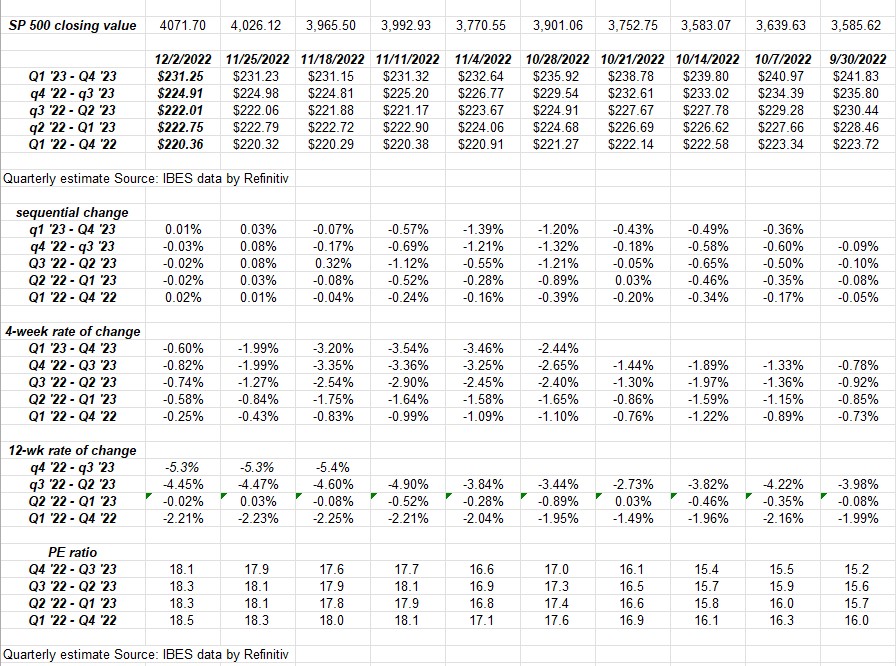What will affect the SP 500 index
2022.12.07 02:41
[ad_1]
What will affect the SP500 index
Budrigannews.com – (NYSE) Toll Brothers likewise Costco (NASDAQ: will be examined when they report their most recent profit this week. Despite the rise in interest rates, TOL still anticipates a 13% year-over-year increase in EPS. Costco had an extreme day last week after it showed comp’s easing back, yet that is not something terrible. The stock has been an outright beast and it appeared to acquire share in the pandemic, however presently it’s basically getting back to generally expected.
SP 500 Data:
The forward 4-quarter gauge (FFQE) fell marginally to $224.91 from last week’s $224.98 and versus the 9/30/22 FFQE of $230.43.
The SP 500 earnings yield as of Friday night was 5.52 percent versus the previous week’s 5.59 percent and the 9/30 compare of 6.43 percent; the PE ratio as of last Friday, December 2nd, was 18.1x versus the 9/30/22 PE of 15.5x;
Rate-of-change:

If you expand the chart, you’ll see that the erosion of earnings per share has slowed down over the past three weeks, following significant negative revisions from mid-October to mid-November 22.
I wouldn’t put too much stock in the improving rate of change because there is so little earnings activity.
Prophet (NYSE:), NYSE: FedEx, likewise Nike and a few other large businesses will report before Christmas or within the next 20 days; therefore, keep an eye on those outcomes.
Expected quarterly growth rates through 2023
This was pointed out last week, but note how the EPS growth rates are thought to trough in Q2 ’23. Ignore ’24 – it’s just too early, but there is softening expected for the next 3 quarters, but it’s not harshly negative.

A table from Refnitiv provides a more comprehensive view of sector EPS growth rates.
The forecasts for SP 500 EPS growth of 10% in 2022 and 2023 have both been halved, with 2023 experiencing more severe reductions than 2022
S&P 500 EPS growth has slowed both the current and anticipated growth rates through 2023. It is difficult to discern any distinct earnings momentum outside of the health care sector and industrial segments like defense. Even the energy sector appears a little shaky, as evidenced by its trading activity and the energy sector estimate in the most recent table.
It can always get worse, but how much of that is already reflected in the valuations and stock prices of today?
According to the final table, technology is actually expected to grow slightly faster in 2023 than in 2022. This makes sense given the falling value of the dollar, but clearly it will not be as strong as the tech industry’s earnings and revenue growth over the past five years.
It’s almost as though everyone on Wall Street bet on a recession, but it hasn’t happened. was in good health: Keep in mind that “services” make up a much larger portion of the US economy than manufacturing does. Currently, it is almost 80 percent services and 20 percent manufacturing. According to a report from the St. Louis FRED (Federal Reserve Economic Database), “durable manufacturing,” also known as manufacturing with a very long cycle, includes Boeing (NYSE:), and a few defense-related businesses), Ford (NYSE:), as well as GM (NYSE:), now account for only 5% of GDP growth annually, compared to 50%-55% in the 1960s.
The tech mega-caps and software names slowing down is not a good thing: Those names are frequently mentioned in the media.
Accept this all tentatively and significant distrust. It’s only one person’s opinion, which can change quickly.








